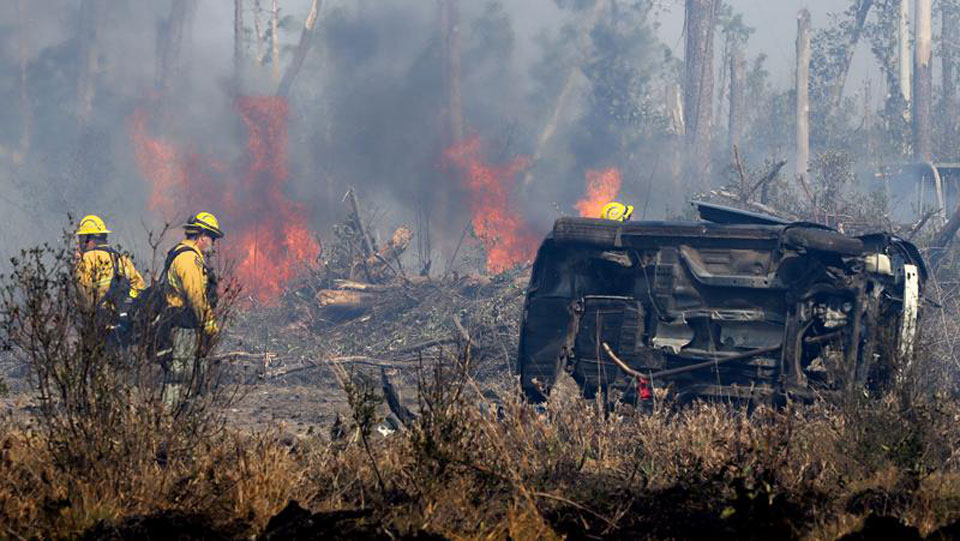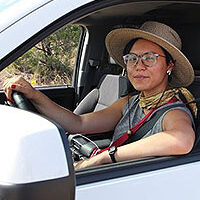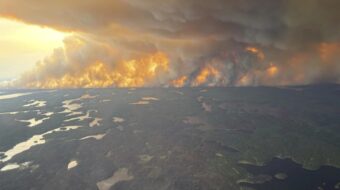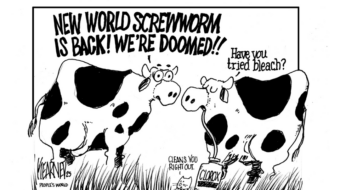
All week, a trio of wildfires has blazed through more than 34,000 acres in the Florida Panhandle, gorging on downed trees that Hurricane Michael left in its wake more than three years ago. The fires have forced more than 1,100 people from their homes.
The three wildfires, collectively called the Chipola Complex, represent a collision of impacts from climate change — and show how stalled disaster recovery can worsen the blow down the road. Hurricane Michael is “the storm that just keeps on giving and giving,” Jimmy Patronis, the state fire marshal and chief financial officer, said in a press conference on Tuesday. “It’s like a ghost. We can’t get rid of the damn thing.”
Hurricane Michael swept across Florida in 2018, killing at least 50 people and razing 2.8 million acres of forests. The dense jumble of dead trees and vegetation — as much as 100 tons per acre — provided ample fuel for intense, towering flames, and an obstacle for the firefighters attempting to control them. “We all saw the potential implications that this storm had for future wildfires,” said David Godwin, director of the Southern Fire Exchange, a regional fire science-sharing program. Experts considered it only a matter of time before the thicket of timber went up in flames.
Though wildfires in the West get more attention, the threat is creeping up in the Southeast United States, too. That means yet another existential threat for Florida to contend with — besides heat, hurricanes, and sea level rise — as the climate warms. A recent UN report said that the threat of wildfires is rising around the world, projecting a 50 percent increase by 2100. “The heating of the planet is turning landscapes into tinderboxes,” the researchers wrote, “while more extreme weather means stronger, hotter, drier winds to fan the flames.”
As of Friday morning, according to the Florida Forest Service, the Bertha Swamp Road Fire, the biggest of the three, smoldered over 33,131 acres east of Panama City and was 40 percent contained. The other two, the Adkins Avenue Fire and Star Ave. Fire, are 875 and 197 acres respectively and have both been 95 percent contained. On Wednesday, firefighters welcomed the first rainfall in several days, which allowed them to make progress in areas they couldn’t reach before.
Across the Southeast, thriving forests and wetlands actually depend on fire, which Indigenous people have long used to manage the land and cultivate certain plants. Southern states have led the nation in prescribed fires, low-intensity burns used to manage flammable shrubs and brush on the forest floor and prevent dangerous wildfires.
But the sheer volume of Hurricane Michael’s wreckage was overwhelming, according to Godwin. To complicate matters, unlike the West’s vast swathes of public forests, most forests in the Southeast are in small, privately owned tracts where slash and loblolly pine trees are grown for timber. That limited the Florida Forest Service’s ability to clear out the dead trees, Godwin said, and complicated the clean-up effort with “the economics of the pocketbooks of the private landowners.” The costs of removing and replanting trees are steep, and he noted many of the ruined forests are in rural, low-income areas.
Unusually dry weather has dialed up Florida’s fire risk, leading the National Interagency Fire Center to forecast “above normal significant fire potential” in the state on March 1, just days before the first flames of the Chipola Complex, which quickly grew under gusty winds. The fires, which have not led to any fatalities so far, mark an ominous start to Florida’s fire season, which runs March through June.
Scientists have found that as climate change worsens droughts and dry spells in the Southeast, the region’s fire seasons are getting longer. At the same time, it’s narrowing the window in which forest managers can safely use prescribed fires. The hurricanes that drop all that fuel on the ground are also intensifying.
All of this means more opportunities for wildfires. Godwin said states need to restore fire-resilient trees like longleaf pine and work with landowners to use prescribed fires even more — especially after hurricanes. That may require tapping into federal funds or creating a system similar to crop insurance, in which farmers are insured against losses from drought or floods, but for forests. Recovering privately owned forests after hurricanes to prevent dangerous blazes “provides greater community resilience and benefits,” he said. “We’re all in this boat together.”
This article was reposted from Grist.org.










